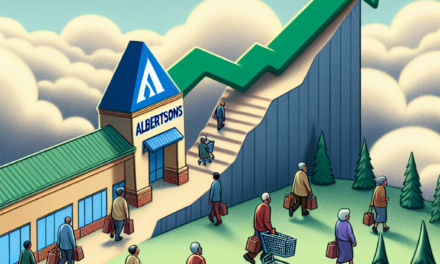“Market Momentum Wanes: Dow Dips 330 Points as Trump Rally Loses Steam”
Introduction
The Dow Jones Industrial Average experienced a significant decline, dropping 330 points as the initial post-election rally, spurred by Donald Trump’s presidential victory, began to wane. This downturn reflects investor concerns and market volatility as the initial optimism surrounding potential pro-business policies and economic reforms gave way to uncertainty about the new administration’s ability to implement its agenda. The fading rally highlights the complexities and challenges facing the market as it adjusts to the evolving political landscape and its potential impact on economic growth and corporate profitability.
Analysis Of The Post-Election Trump Rally And Its Impact On The Dow
The post-election period following Donald Trump’s victory in the 2016 U.S. presidential election was marked by a significant rally in the stock market, often referred to as the “Trump Rally.” This surge was largely driven by investor optimism surrounding Trump’s proposed economic policies, which included tax cuts, deregulation, and increased infrastructure spending. However, as the initial excitement began to wane, the Dow Jones Industrial Average experienced a notable decline, dropping 330 points. This shift in market sentiment prompts a closer examination of the factors contributing to the rally’s initial success and the subsequent downturn.
Initially, the Trump Rally was fueled by the anticipation of pro-business policies that were expected to stimulate economic growth. Investors were particularly enthusiastic about the prospect of corporate tax cuts, which promised to increase profitability for businesses and, in turn, boost stock prices. Additionally, the promise of deregulation across various industries, including finance and energy, was seen as a catalyst for increased corporate earnings. The market’s positive response was further bolstered by expectations of significant infrastructure spending, which was anticipated to create jobs and drive economic expansion.
However, as time progressed, the initial euphoria began to dissipate, and the complexities of implementing these policies became more apparent. One of the primary reasons for the Dow’s decline was the growing uncertainty surrounding the feasibility and timeline of Trump’s proposed economic measures. While the administration had outlined ambitious plans, the legislative process proved to be more challenging than anticipated. This uncertainty led to increased volatility in the market, as investors grappled with the potential delays and modifications to the proposed policies.
Moreover, geopolitical tensions and global economic factors also played a role in tempering the initial optimism. Concerns over trade relations, particularly with China, introduced an element of unpredictability that weighed heavily on investor sentiment. The potential for trade wars and the imposition of tariffs raised fears of retaliatory measures that could adversely impact global trade and economic growth. These concerns were compounded by fluctuations in currency markets and the potential for rising interest rates, which further contributed to the market’s unease.
In addition to these external factors, internal market dynamics also influenced the Dow’s performance. As the rally progressed, some investors began to question whether stock valuations had become overly inflated. The rapid rise in stock prices led to concerns about a potential market correction, prompting some investors to adopt a more cautious approach. This shift in sentiment was reflected in the increased selling pressure, which contributed to the Dow’s decline.
Despite the downturn, it is important to recognize that the post-election Trump Rally had a lasting impact on the market. It highlighted the significant influence of political developments on investor behavior and underscored the importance of policy expectations in shaping market trends. While the initial surge may have faded, the rally served as a reminder of the complex interplay between politics and economics, and the need for investors to remain vigilant in navigating these dynamics.
In conclusion, the Dow’s 330-point drop following the post-election Trump Rally can be attributed to a combination of factors, including policy uncertainty, geopolitical tensions, and internal market dynamics. As investors continue to assess the evolving economic landscape, it remains crucial to consider both the opportunities and challenges presented by political developments and their potential impact on the market.
Factors Contributing To The Dow’s 330-Point Decline
The Dow Jones Industrial Average experienced a significant decline, dropping 330 points as the initial enthusiasm following the post-election Trump rally began to wane. This downturn can be attributed to a confluence of factors that have collectively contributed to the market’s recent volatility. Understanding these elements is crucial for investors and analysts alike as they navigate the complexities of the current economic landscape.
Firstly, investor sentiment has been notably impacted by the uncertainty surrounding the implementation of President Trump’s proposed economic policies. While the initial reaction to his election was marked by optimism, driven by expectations of tax cuts, deregulation, and increased infrastructure spending, the reality of translating these promises into actionable policies has proven to be more challenging. As legislative processes unfold, delays and potential modifications to these policies have led to growing skepticism among investors, who are now reassessing their initial exuberance.
Moreover, global economic conditions have also played a significant role in the Dow’s decline. The international market landscape is fraught with uncertainties, including ongoing trade tensions and geopolitical risks. The trade disputes, particularly between the United States and China, have created an environment of unpredictability, affecting global supply chains and corporate earnings. As these tensions persist, they continue to weigh heavily on investor confidence, contributing to the market’s downward trajectory.
In addition to geopolitical factors, domestic economic indicators have also influenced market performance. Recent data releases have painted a mixed picture of the U.S. economy, with some indicators suggesting a slowdown in growth. For instance, manufacturing output and consumer spending have shown signs of weakening, raising concerns about the sustainability of economic expansion. These indicators are closely monitored by investors, who use them to gauge the health of the economy and make informed decisions about their portfolios.
Furthermore, the Federal Reserve’s monetary policy has been a critical factor in shaping market dynamics. The central bank’s decisions regarding interest rates have a profound impact on investor behavior. In recent months, the Fed has signaled a more cautious approach, balancing the need to support economic growth with the imperative to keep inflation in check. This cautious stance has led to speculation about future rate hikes, which in turn has influenced market sentiment. Investors are acutely aware that higher interest rates can increase borrowing costs and potentially dampen economic activity, prompting them to adjust their investment strategies accordingly.
Additionally, corporate earnings reports have been a mixed bag, with some companies exceeding expectations while others have fallen short. This variability in earnings performance has added another layer of complexity to the market environment. Investors are closely scrutinizing these reports to assess the financial health of individual companies and sectors, which can lead to fluctuations in stock prices and contribute to broader market movements.
In conclusion, the Dow’s 330-point decline is the result of a multifaceted interplay of factors, including policy uncertainties, global economic conditions, domestic economic indicators, Federal Reserve actions, and corporate earnings performance. As these elements continue to evolve, they will undoubtedly shape the trajectory of the market in the coming months. Investors and analysts must remain vigilant, staying informed about these developments to navigate the challenges and opportunities that lie ahead.
Historical Context: Comparing Past Post-Election Market Reactions
The stock market’s reaction to presidential elections has long been a subject of interest for investors, economists, and historians alike. The recent drop of 330 points in the Dow Jones Industrial Average, marking the fading of the post-election Trump rally, provides an opportunity to examine how past elections have influenced market behavior. Historically, the stock market’s response to presidential elections has varied significantly, often reflecting the political and economic climate of the time. By comparing these reactions, we can gain insights into the factors that drive market sentiment and the potential implications for future elections.
In the aftermath of a presidential election, the stock market often experiences heightened volatility as investors react to the anticipated policies of the incoming administration. For instance, the election of Franklin D. Roosevelt in 1932, during the depths of the Great Depression, initially led to a decline in the stock market. However, as his New Deal policies began to take shape, investor confidence was gradually restored, resulting in a significant market recovery. This historical example underscores the importance of policy expectations in shaping market reactions.
Similarly, the election of Ronald Reagan in 1980 was met with a positive response from the stock market, as investors anticipated his pro-business policies and tax cuts. The subsequent bull market of the 1980s was fueled by these expectations, demonstrating how political ideology and economic policy can influence investor sentiment. In contrast, the election of Barack Obama in 2008 occurred amidst the global financial crisis, leading to initial market uncertainty. However, as his administration implemented measures to stabilize the economy, the market eventually rebounded, highlighting the role of government intervention in restoring investor confidence.
The post-election Trump rally of 2016 serves as another example of how market reactions can be driven by policy expectations. Following Donald Trump’s victory, the stock market surged as investors anticipated tax cuts, deregulation, and increased infrastructure spending. This optimism was reflected in the Dow’s significant gains in the months following the election. However, as the initial excitement waned and the complexities of policy implementation became apparent, the market’s enthusiasm began to fade, culminating in the recent 330-point drop.
Comparing these historical examples reveals that while the immediate post-election market reaction can be influenced by a variety of factors, including political ideology and economic conditions, the long-term impact is often determined by the actual implementation and effectiveness of the anticipated policies. Moreover, it is important to recognize that external factors, such as global economic trends and geopolitical events, can also play a significant role in shaping market behavior.
In conclusion, the stock market’s response to presidential elections is a complex interplay of expectations, policy implementation, and external influences. By examining past post-election market reactions, we can better understand the factors that drive investor sentiment and the potential implications for future elections. As the recent decline in the Dow Jones Industrial Average illustrates, initial optimism can quickly give way to uncertainty as the realities of governance come into focus. This historical context serves as a reminder that while elections can have a significant impact on the stock market, the true test lies in the ability of the incoming administration to deliver on its promises and navigate the challenges of an ever-changing global economy.
Investor Sentiment: How The Market Is Reacting To Political Changes
The recent decline in the Dow Jones Industrial Average, which saw a drop of 330 points, has sparked discussions among investors and analysts about the shifting dynamics of investor sentiment in response to political changes. This downturn marks a significant departure from the post-election rally that followed the election of Donald Trump, a period characterized by optimism and bullish market behavior. As the initial euphoria of the election results begins to wane, market participants are now recalibrating their expectations in light of emerging political realities and policy uncertainties.
In the immediate aftermath of the election, the market experienced a surge driven by expectations of pro-business policies, including tax cuts, deregulation, and infrastructure spending. These anticipated measures were seen as catalysts for economic growth, prompting investors to pour capital into equities, particularly in sectors poised to benefit from such policies. However, as the initial excitement subsides, investors are beginning to reassess the feasibility and timing of these policy implementations. The complexities of the legislative process, coupled with political opposition and intra-party disagreements, have introduced a level of uncertainty that is now being reflected in market behavior.
Moreover, the geopolitical landscape has also played a role in shaping investor sentiment. Recent developments on the international stage, including trade tensions and diplomatic challenges, have added layers of complexity to the economic outlook. Investors are increasingly aware that geopolitical risks can have profound implications for global markets, influencing everything from currency valuations to commodity prices. As a result, there is a growing sense of caution as market participants weigh the potential impact of these factors on their investment strategies.
In addition to political and geopolitical considerations, economic indicators have also contributed to the evolving market sentiment. While certain economic data points have shown strength, such as employment figures and consumer confidence, others have raised concerns. For instance, inflationary pressures and the Federal Reserve’s monetary policy stance are key areas of focus for investors. The prospect of rising interest rates, intended to curb inflation, has implications for borrowing costs and corporate profitability, factors that are closely monitored by market participants.
Furthermore, the recent market volatility underscores the importance of investor psychology in shaping market trends. The transition from a period of exuberance to one of caution highlights the role of sentiment in driving market movements. As investors navigate this complex landscape, they are increasingly relying on a combination of fundamental analysis and sentiment indicators to guide their decisions. This approach reflects a broader understanding that markets are not solely driven by economic fundamentals but are also influenced by perceptions, expectations, and behavioral factors.
In conclusion, the recent drop in the Dow Jones Industrial Average serves as a reminder of the intricate interplay between political developments, economic indicators, and investor sentiment. As the post-election rally fades, market participants are adjusting their strategies to account for the uncertainties and challenges that lie ahead. While the path forward remains uncertain, the evolving landscape presents both risks and opportunities for investors. By staying informed and adaptable, investors can navigate these changes and position themselves to capitalize on potential market shifts. As always, a balanced approach that considers both short-term fluctuations and long-term trends will be essential in managing risk and achieving investment objectives.
The Role Of Economic Indicators In The Dow’s Recent Performance
The recent decline in the Dow Jones Industrial Average, which saw a drop of 330 points, has raised questions about the sustainability of the post-election rally that followed Donald Trump’s victory. This downturn highlights the intricate relationship between economic indicators and market performance, underscoring the importance of understanding these metrics in assessing the health of the stock market. As investors navigate the complexities of market dynamics, it becomes crucial to examine how various economic indicators have influenced the Dow’s recent performance.
Initially, the post-election rally was fueled by optimism surrounding potential policy changes, including tax cuts, deregulation, and infrastructure spending, which were expected to stimulate economic growth. However, as the initial euphoria began to wane, investors turned their attention to more concrete economic indicators to gauge the market’s trajectory. One such indicator is the Gross Domestic Product (GDP), which provides a comprehensive measure of a country’s economic activity. A robust GDP growth rate often signals a healthy economy, encouraging investor confidence. Conversely, any signs of slowing growth can lead to market apprehension, as was evident in the recent Dow decline.
In addition to GDP, employment data plays a pivotal role in shaping market sentiment. The U.S. labor market’s performance, as reflected in unemployment rates and job creation figures, directly impacts consumer spending, a critical driver of economic growth. A strong labor market typically boosts consumer confidence, leading to increased spending and, consequently, higher corporate earnings. However, any indication of weakening employment figures can trigger concerns about future economic stability, contributing to market volatility.
Moreover, inflation rates are closely monitored by investors, as they influence the Federal Reserve’s monetary policy decisions. Rising inflation can erode purchasing power and prompt the Fed to raise interest rates, which can increase borrowing costs for businesses and consumers alike. This, in turn, can dampen economic growth prospects and weigh on stock market performance. The recent fluctuations in the Dow can be partly attributed to investor anxiety over potential interest rate hikes in response to inflationary pressures.
Another critical factor is corporate earnings reports, which provide insights into the financial health of individual companies and sectors. Strong earnings can bolster investor confidence and drive stock prices higher, while disappointing results can have the opposite effect. As the post-election rally began to fade, investors scrutinized earnings reports more closely, seeking evidence of sustainable growth amid an uncertain economic landscape.
Furthermore, geopolitical events and trade policies also play a significant role in shaping market dynamics. The global interconnectedness of economies means that developments in one region can have far-reaching implications for markets worldwide. For instance, trade tensions or political instability can disrupt supply chains and impact corporate profitability, leading to market fluctuations. The recent Dow decline reflects investor concerns over such uncertainties, as they reassess the potential risks and rewards in the current environment.
In conclusion, the Dow’s recent performance underscores the complex interplay of various economic indicators and their influence on market sentiment. While the initial post-election rally was driven by optimism, the subsequent decline highlights the importance of closely monitoring economic data to understand the underlying factors affecting market trends. As investors continue to navigate this intricate landscape, a comprehensive understanding of these indicators will be essential in making informed decisions and anticipating future market movements.
Expert Opinions On The Future Of The Stock Market Post-Election
The recent decline in the Dow Jones Industrial Average, which saw a drop of 330 points, has sparked widespread discussion among financial experts about the future trajectory of the stock market in the post-election landscape. This downturn marks a significant shift from the post-election rally that followed the election of Donald Trump, a period characterized by investor optimism and buoyant market activity. As the initial enthusiasm wanes, experts are now evaluating the factors that could influence market performance in the coming months.
One of the primary considerations is the uncertainty surrounding the implementation of the new administration’s economic policies. While the initial rally was fueled by expectations of tax cuts, deregulation, and increased infrastructure spending, the reality of translating these promises into actionable policies has proven to be more complex. Analysts suggest that the market’s recent volatility reflects growing skepticism about the feasibility and timing of these initiatives. Consequently, investors are adopting a more cautious approach, reassessing their portfolios in light of potential policy delays or modifications.
Moreover, the global economic environment continues to play a crucial role in shaping market dynamics. With geopolitical tensions and trade negotiations ongoing, the international landscape remains fraught with uncertainties that could impact investor sentiment. For instance, the potential for trade disputes to escalate poses a risk to global supply chains and economic growth, factors that are closely monitored by market participants. In this context, experts emphasize the importance of maintaining a diversified investment strategy to mitigate risks associated with external shocks.
In addition to policy and geopolitical factors, the role of central banks cannot be overlooked. The Federal Reserve’s monetary policy decisions, particularly regarding interest rates, are pivotal in influencing market behavior. As the Fed signals its intentions to gradually raise rates, investors are recalibrating their expectations for future economic conditions. Higher interest rates typically lead to increased borrowing costs, which can dampen corporate profits and consumer spending, thereby exerting downward pressure on stock prices. Consequently, market observers are keenly attuned to the Fed’s communications, seeking clarity on the pace and magnitude of future rate hikes.
Furthermore, corporate earnings remain a fundamental driver of stock market performance. As companies report their quarterly results, investors scrutinize earnings reports for insights into business health and growth prospects. While some sectors have demonstrated resilience, others face headwinds from changing consumer preferences and technological disruptions. Analysts highlight the importance of distinguishing between short-term fluctuations and long-term trends when evaluating corporate performance, as this distinction can inform more strategic investment decisions.
In light of these multifaceted influences, expert opinions on the future of the stock market post-election are varied. Some maintain a cautiously optimistic outlook, citing the underlying strength of the U.S. economy and the potential for policy reforms to eventually materialize. Others, however, urge prudence, pointing to the myriad uncertainties that could derail market stability. As investors navigate this complex environment, the consensus underscores the need for vigilance and adaptability.
In conclusion, the recent decline in the Dow Jones Industrial Average serves as a reminder of the inherent volatility in financial markets. As the post-election rally fades, experts continue to analyze a confluence of factors that will shape the stock market’s future trajectory. By considering policy developments, global economic conditions, central bank actions, and corporate earnings, investors can better position themselves to respond to the evolving landscape.
Strategies For Investors During Market Volatility After Elections
In the wake of the recent election, the financial markets have experienced significant fluctuations, with the Dow Jones Industrial Average dropping 330 points as the initial post-election rally, spurred by the election of Donald Trump, begins to wane. This volatility has left many investors questioning their strategies and seeking guidance on how to navigate these uncertain times. Understanding the dynamics at play and adopting a well-considered approach can help investors manage their portfolios effectively during such periods of market turbulence.
Firstly, it is crucial for investors to maintain a long-term perspective. Market volatility, particularly following major political events like elections, is not uncommon. Historical data suggests that while markets may react sharply in the short term, they often stabilize and continue on their growth trajectory over the long haul. Therefore, investors should resist the urge to make impulsive decisions based on short-term market movements. Instead, they should focus on their long-term investment goals and remain committed to their financial plans.
Moreover, diversification remains a key strategy in managing risk during volatile times. By spreading investments across various asset classes, sectors, and geographic regions, investors can mitigate the impact of market fluctuations on their portfolios. Diversification helps ensure that the poor performance of one investment is offset by the better performance of others, thereby reducing overall risk. Investors should regularly review their portfolios to ensure they are well-diversified and aligned with their risk tolerance and investment objectives.
In addition to diversification, maintaining a balanced portfolio is essential. This involves having an appropriate mix of equities, fixed income, and other asset classes that align with an investor’s risk profile and investment horizon. During periods of market volatility, it may be tempting to shift entirely to safer assets like bonds or cash. However, doing so could result in missed opportunities for growth when the market rebounds. A balanced approach allows investors to benefit from potential market upswings while still providing some protection against downturns.
Furthermore, investors should consider the importance of staying informed and adaptable. Keeping abreast of economic indicators, policy changes, and global events can provide valuable insights into market trends and potential risks. This knowledge enables investors to make informed decisions and adjust their strategies as needed. However, it is equally important to avoid overreacting to every piece of news or market movement. Investors should focus on the broader economic picture and how it aligns with their investment strategy.
Additionally, consulting with financial advisors can be beneficial during volatile periods. Advisors can provide objective insights and help investors navigate complex market conditions. They can assist in reassessing investment goals, evaluating risk tolerance, and making necessary adjustments to portfolios. Having a professional perspective can offer reassurance and clarity, especially when emotions run high during market downturns.
Lastly, maintaining discipline and emotional resilience is vital. Market volatility can evoke fear and anxiety, leading to hasty decisions that may not align with an investor’s long-term goals. By staying disciplined and adhering to a well-thought-out investment plan, investors can avoid making decisions based on emotions. Practicing patience and maintaining confidence in their strategies can help investors weather the storm and emerge stronger when the market stabilizes.
In conclusion, while the Dow’s recent drop may cause concern, it is essential for investors to remain focused on their long-term objectives. By employing strategies such as diversification, maintaining a balanced portfolio, staying informed, seeking professional advice, and exercising discipline, investors can navigate market volatility effectively and position themselves for future success.
Q&A
1. **What caused the Dow to drop 330 points?**
The Dow dropped 330 points as the post-election rally, driven by optimism about President Trump’s economic policies, began to fade.
2. **When did the Dow experience this drop?**
The drop occurred shortly after the U.S. presidential election, during the period when initial market enthusiasm was waning.
3. **What was the initial cause of the post-election rally?**
The rally was initially caused by investor optimism about potential tax cuts, deregulation, and infrastructure spending promised by President Trump.
4. **How did investors react to the fading rally?**
Investors began to reassess the feasibility and timing of the proposed economic policies, leading to a sell-off in the market.
5. **Which sectors were most affected by the Dow’s drop?**
Financial and industrial sectors, which had previously gained on expectations of policy changes, were among the most affected.
6. **What other factors contributed to the market’s decline?**
Concerns about geopolitical tensions, interest rate hikes, and global economic uncertainties also contributed to the market’s decline.
7. **What was the broader impact of the Dow’s decline on the market?**
The decline signaled a shift in investor sentiment, leading to increased volatility and a more cautious approach to stock investments.
Conclusion
The Dow Jones Industrial Average fell by 330 points as the initial post-election rally, spurred by Donald Trump’s victory, began to wane. This decline suggests that investor optimism, driven by expectations of pro-business policies and economic growth under the new administration, is being tempered by uncertainties and potential challenges. Market participants may be reassessing the implications of Trump’s policies on trade, regulation, and fiscal stimulus, leading to increased volatility and a more cautious approach. The fading rally indicates a shift from speculative enthusiasm to a more measured evaluation of the economic landscape and policy impacts.





